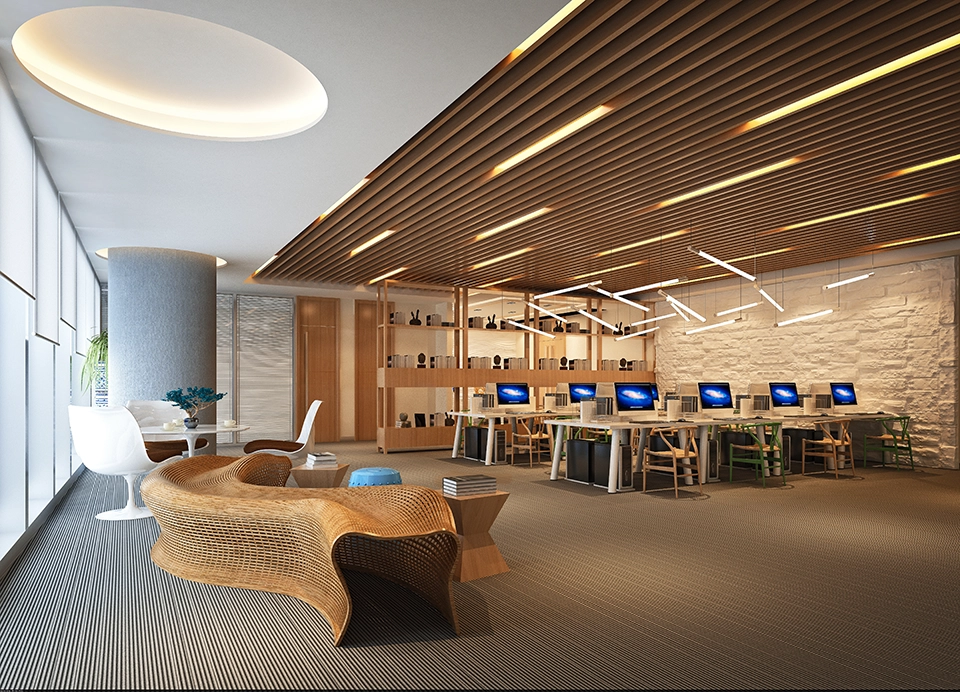How Office Interiors Can Improve Mental Health and Wellbeing
30-04-2025 | 5m read

The conversation around mental health in the workplace has never been more important. As businesses strive to create environments where people can thrive, office design has become a critical part of the solution.
Your office isn’t just a place to work—it’s an ecosystem that influences mood, stress levels, focus, and overall happiness. At Morpho Dimensions, we believe that thoughtful design choices can enhance mental wellbeing, reduce burnout, and foster a more positive company culture.
Let’s explore how interior design can directly impact mental health—and how to create spaces where your team feels supported, inspired, and balanced.
Our surroundings shape how we think, feel, and perform. The field of environmental psychology has long proven that factors like light, color, layout, and acoustics can either enhance or hinder wellbeing.
A well-designed office promotes:
Reduced stress and anxiety
Improved concentration and creativity
Greater job satisfaction
Stronger social connection
When design supports mental health, it leads to healthier, happier, and more productive teams.

Natural light is one of the most powerful design elements for wellbeing. Exposure to daylight regulates circadian rhythms, boosts serotonin levels, and combats fatigue.
Position desks near windows and glass partitions.
Use light-diffusing blinds instead of heavy curtains.
Add mirrors and reflective surfaces to amplify sunlight.
Incorporate skylights or light wells in deep spaces.
At Morpho Dimensions, we prioritize daylight optimization in every project—because light isn’t just functional, it’s emotional.
Bringing nature indoors can dramatically reduce stress and restore focus. Biophilic design—incorporating natural elements—helps employees feel calm and connected.
Add plants to desks, hallways, and communal areas.
Introduce living walls or indoor gardens.
Use natural materials like wood, bamboo, and stone.
Create views of nature or nature-inspired artwork.
Nature has a grounding effect that rebalances energy, improving both mental clarity and emotional health.
Color influences emotions more than most people realize. By applying color psychology, designers can create spaces that support focus, relaxation, or creativity.
Blue: Promotes calm and concentration.
Green: Represents balance, growth, and restoration.
Yellow: Uplifts mood and energy levels.
Neutrals: Provide a soothing, grounded backdrop.
Avoid harsh contrasts or overly stimulating colors that can cause visual stress. Instead, use soft, balanced palettes for a tranquil environment.
Uncontrolled noise is one of the biggest sources of stress in open offices. Constant interruptions can elevate cortisol levels and lower productivity.
Install acoustic panels or sound-absorbing materials.
Use carpets, curtains, and soft furnishings to dampen sound.
Designate quiet zones for focus and collaborative areas for discussions.
A good acoustic balance ensures employees can concentrate while still feeling connected to their team.
Physical comfort directly impacts mental wellbeing. Poor posture or discomfort can lead to fatigue and frustration over time.
Provide ergonomic furniture—adjustable chairs, desks, and monitor stands.
Allow for movement and posture variation with sit-stand desks.
Ensure ample space for stretching and circulation.
At Morpho Dimensions, we design for both physical health and psychological ease, ensuring every workspace feels intuitive and supportive.

Isolation is a major contributor to workplace anxiety and disengagement. Office layouts that foster interaction and collaboration help build community and belonging.
Create inviting breakout zones and lounges.
Incorporate open café spaces for informal conversations.
Use flexible furniture that encourages spontaneous collaboration.
When employees feel connected, trust and morale naturally increase.
Just as important as collaboration are quiet zones for reflection and rest. Restorative spaces allow employees to recharge during busy days.
Introduce wellness or meditation rooms.
Add soft lighting, calming colors, and comfortable seating.
Include sensory elements like soft textures, ambient music, or water features.
These micro-break zones signal that your organization values mental health and balance.
Wellbeing also comes from feeling seen and supported. Spaces that reflect diverse needs—whether sensory preferences, accessibility, or work styles—empower every employee to feel comfortable and included.
Examples include:
Adjustable lighting and temperature controls
Gender-neutral restrooms
Quiet pods for neurodiverse employees
Flexible furniture arrangements
Inclusive design is, by nature, mentally supportive design.

At Morpho Dimensions, we integrate wellbeing principles into every project through our Human-Centered Design Framework, which focuses on:
Natural connection: maximizing light, air, and greenery
Comfort and flow: optimizing ergonomics and space layouts
Emotional balance: using colors, textures, and sound to enhance mood
Cultural alignment: ensuring spaces reflect company values and people-first design
Our mission is to help organizations create work environments where mental health thrives alongside performance.
Office interiors have a profound impact on how employees feel, think, and perform. By focusing on natural light, comfort, color, and community, you can build a workspace that truly supports mental health and wellbeing.
At Morpho Dimensions, we believe that great design doesn’t just look good—it feels good. Because when people feel their best, they do their best.
Ready to design a workspace that supports wellbeing?
Let Morpho Dimensions help you create an office where design and mental health work hand in hand.
Visit: www.morphodimensions.com
Conference rooms are no longer just enclosed boxes with long tables and static screens. In the era of hybrid teams,...
Conference rooms are no longer just enclosed boxes with long tables and static screens. In the era of hybrid teams,...
Conference rooms are no longer just enclosed boxes with long tables and static screens. In the era of hybrid teams,...